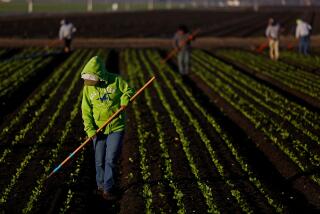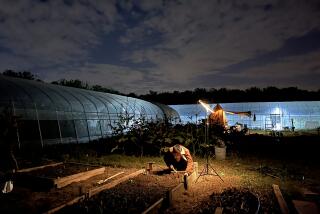National Agenda : Farmers Saying Nyet! to Russia Land Reform : * The government’s race to privatize collectives is meeting stiff resistance in the fields.
- Share via
VERNY PUT COLLECTIVE FARM, Russia — If he wanted to, Fyodor Klimov could break out of his greasy, low-paid job as a tractor mechanic here and become his own master, owner of several free acres of land whose bounty he alone would reap.
But Klimov is not even tempted.
“It’s better to survive in a collective than alone,” said the wiry, icy-eyed man of 35. There was a chorus of agreement from weathered fellow mechanics huddled on benches in a dinosaur park of giant tractors.
“Fuel is expensive, there’s no equipment, there are no spare parts. . . . If you want something of your own, you can keep a cow and piglets in the village,” Klimov said.
For Russian President Boris N. Yeltsin to succeed in the radical land reform he is struggling to introduce this year, he must change Fyodor Klimov--and the heritage that has produced millions of peasants who prefer almost anything to going it alone.
Convinced by its Western-oriented economists that Russia will never be able to feed itself unless it develops a massive private farming sector, the Russian government is launching the biggest land privatization program the world has ever seen.
It decreed in December that money-losing collective farms must “reorganize” by the end of 1992. It has also stopped subsidies to the collective farms and begun funneling billions of rubles into start-up financing for private farmers willing to buy or simply take land from the inefficient group farms and work it themselves.
But the Russian countryside has ideas of its own.
Not for nothing is Klimov’s collective farm named Verny Put--the Right Way. Having hit on its own Right Way in the collectivist philosophy of the old Communist regime, it will not easily deviate.
When the farm in the northern Volga River region of Nizhny Novgorod voted last month on “reorganization,” the workers just said no. They would not accept government proposals to change their farm into a jointly held corporation or a cooperative; they would remain a kolkhoz, a collective farm.
“When everything is getting worse, the only source of protection is the kolkhoz, “ said Verny Put chairman Nikolai Krasnov. “In Russia, when things get bad, we try not to split up but to unite.”
Things have gotten bad in Russia so often that the obshchina , or community, became the most powerful of peasant traditions, the polar opposite of the American frontier image of lone pioneer families striking out into the wilderness.
When dictator Josef Stalin began forcing the Soviet peasantry onto collective farms in the late 1920s, his Communist ideology played into those old habits of banding together. Millions died in the famines and repression of the collectivization program, but it took. And now, 60 years later, three generations have so thoroughly forgotten what it means to be a private farmer that the government’s attempted reforms appear to elicit little but fear.
“If the collective farms are broken up, we’ll die of hunger,” Klavdia Privalova, director of a small dairy factory in the nearby town of Voskresenskoye, said. “And I’ll say that even if you point a pistol at me.”
The aversion to private farming shows even more clearly at the neighboring Mir (Peace) Collective Farm, a typical conglomeration of 700 workers encompassing 11 villages.
Pavel Gromov, the plain-spoken 28-year-old overseer of Mir’s livestock, had clearly mulled over the options of breaking out of the kolkhoz-- and given up the idea.
Suppose he decided to raise coypu, muskrat-like animals, to sell their fur, he said.
“You can get good money for that, but you’d need 10 tons of food concentrates to feed them, and for that you have to work five to 10 hectares (24.7 acres) of land. Nothing can come of it. I need equipment, I need loans. Even if I take 7 hectares (17.3 acres) and get a 200,000-ruble loan (about $2,000), where will I get the equipment?”
Given such financial restraints, few private farms will arise, Gromov said, but at the same time ‘it looks like the government policy is to force through its line--it wants to destroy the kolkhoz. “
The Russian government denies that it is imposing a forced “de-collectivization” as painful for the peasantry as Stalin’s policy. No one will stop collective farms from retaining their form if they choose, government economist Alexei Ulyukayev said recently.
But in the outposts of the Russian countryside, amid the snow-dusted pines and dappled birches that stretch boundlessly away from the rutted roads, kolkhoz officials appear to have good reason to be paranoid.
Vadim Privalov, Mir’s energetic young chairman, described the squeeze on the kolkhoz. In recent months, while prices for meat and milk have tripled or quintupled, the prices on tractors and other equipment have skyrocketed by a factor of up to 50 and fertilizer by up to 20 times.
Feed has become so difficult to obtain that the kolkhoz has trimmed its herds, more than halving the number of pigs it keeps. Privalov figures he has enough fuel on hand for this spring’s sowing. But with gasoline prices expected to jump next, he says the farm will have to go deep into debt to buy the fuel for autumn harvesting.
Mir made a nice profit of 2.5 million rubles (about $25,000) last year; this year, Privalov said, it will probably end up losing money.
“Today, without subsidies, agriculture cannot survive,” he said. “If the economic situation keeps getting worse, a lot of farms will just fall apart. They won’t be able to produce anymore and will just go bankrupt. Without masters, the land will go fallow and the pensioners will lose all their social support.”
Already, agricultural output in Privalov’s region dropped by 30% last year, largely because of shortfalls in feed and materials. And with farmers unable to afford fertilizer and equipment, experts believe 1992 may see a nationwide drop of 20% to 30%.
Despite the subsidies they receive under the land reform, private farmers face many of the same difficulties, and it shows in the limited headway they have made.
About 71,000 private farms had been created in Russia as of March, according to Ulyukayev, but they were still producing less than 1% of the country’s agricultural output. In the entire Voskresenskoye agricultural district of 30,000 people, only 22 had taken on private farms, and of those, local officials estimate, most have not even gotten off the ground.
Vladimir Tikhonov, one of the most prominent advocates of land reform, acknowledged that in the face of such difficulties, “only a suicide, or a despairing hero who has decided to see whether it’s possible to do anything in these extremely tough conditions, will leave the kolkhoz to start a farm.”
Along with giving up a guaranteed--if modest--income, members who leave the kolkhoz forfeit a wide range of social benefits, from subsidized kindergartens and rents to kolkhoz- supplied wood for their Russian stoves and the myriad little things they pilfer to build and supply their own huts and barns.
Observing the slow progress of Yeltsin’s reforms, some Russian observers question whether the government is going about this the right way.
Mikhail Silvanovich, an editor at the conservative newspaper Selskaya Zhizn, or Country Life, said it seems to him that it would have made more sense to begin reforms by retooling the tractor industry to focus more on the small-scale machinery private farmers need--and then to actually divide the land.
With the reforms just taking on momentum as spring plowing begins, he added, the risk grows that the confusion will lead to an even scantier harvest this year. “If this continues into next winter, we’ll be hungry and cold,” Gromov of Mir predicted angrily.
Actually, the farmers of the Voskresenskoye region, for all its infertile soil, are not worried about themselves; they know they have their cords of wood in the yard, their cow in the barn and their jars upon jars of pickled goods in the basement.
It is the city folk, just emerging from the winter that so many had predicted would bring hunger and unrest, that now have next winter to fear.
“We can always feed ourselves,” Privalov said. “We can always switch to subsistence farming, but that won’t do much for the country.”
Even the most pioneering of private farmers worries that the rapidity of Yeltsin’s reforms may throw the entire agricultural system out of kilter.
Konstantin Mezentsev of Russia’s main private farmers’ association, known as AKOR, admitted that even he is taken aback by the current push for private farms; he once thought the movement would not take on serious momentum for another 10 years. The association is deeply concerned that the government’s rush to create private farms without backing them up with capital and equipment could end badly, he said. Private farmers “are like the pioneers of the Wild West, who know there’s no support,” Mezentsev commented.
The government’s planned 6.5-billion-ruble aid to private farmers this year works out to a subsidy of about 100,000 rubles, or $1,000, per farmer--not even enough to buy a small tractor. The government has also done little so far to help novice farmers get the expert advice they need and to get their produce from the fields to the market.
Outsiders to the traditional channels of the kolkhoz system, private farmers must also struggle just to find suppliers of the seed, fertilizer and pesticides they need.
Ilarion Pisarev, a 78-year-old pensioner who lives in a well-heated wooden house on the Verny Put farm, remembers the last time they tried to do things fast, during Stalin’s collectivization.
“They forced everyone all together into one clump,” he said. “Who knows if it was a mistake? Then we all got used to it again.”
Asked which form of farming, private or collective, is better in the final analysis, Pisarev smiled through his spade-shaped gray beard.
“Back then, everyone who preached died,” he recalled pointedly. And he would say no more.
Going Private: A Tough Row to Hoe
A Russian who decides to become a private farmer goes about it like this:
1. He applies to his regional Committee on Land Reform, an arm of local government, saying how much land he wants, which crops he plans to grow and who will be working the land with him. The plot comes either from a collective farm, if he is a member, or from a “redistribution fund” of extra land.
2. The committee is required to review the application promptly, alter it as needed and pass it on for approval to the head of the local or regional government.
3. Once his plan has the go-ahead, the would-be farmer generally needs to get a bank loan, and for that he needs bank approval and usually agreement from a local organization or business to act as guarantor.
4. He then has to find equipment for working his fields. If he was a collective farm member, he has the right to a portion of farm property, often a miniscule one. Prices on tractors and other equipment are exorbitant, often 20 or 30 times higher than last year.
5. The farmer must also somehow obtain seed and fertilizer, either through what remains of state suppliers or through his local collective farm, which may or may not choose to help him.
6. Then, if he has any strength left, he may actually start to grow crops.
Source: Selskaya Zhizn
More to Read
Sign up for Essential California
The most important California stories and recommendations in your inbox every morning.
You may occasionally receive promotional content from the Los Angeles Times.










